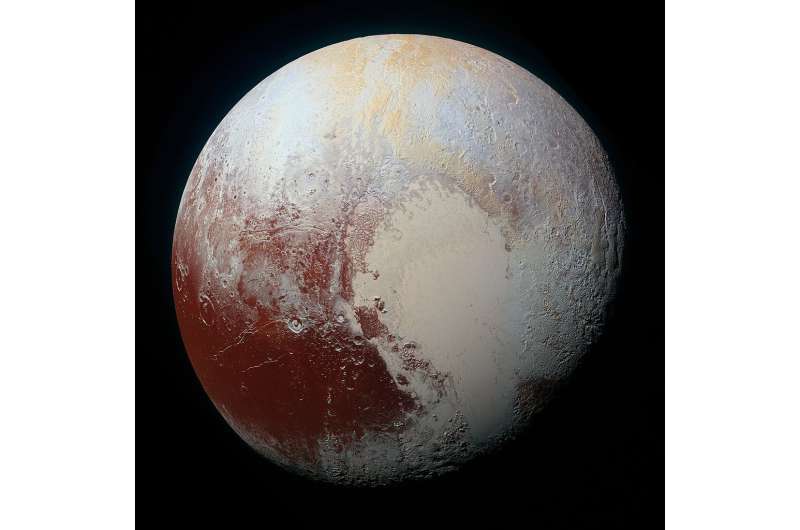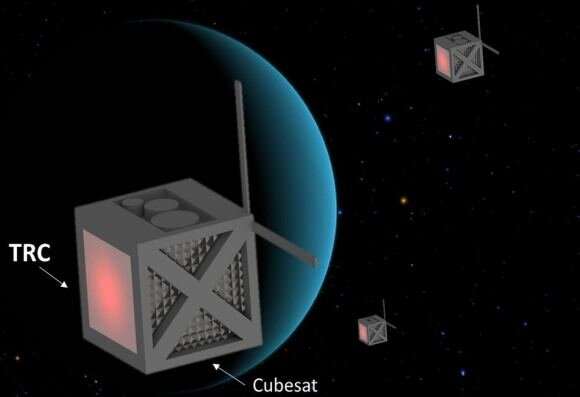This article has been reviewed according to Science X's editorial process and policies. Editors have highlighted the following attributes while ensuring the content's credibility:
fact-checked
trusted source
proofread
Exploring the outer solar system takes power: Here's a way to miniaturize nuclear batteries for deep space

As science and technology advance, we're asking our space missions to deliver more and more results. NASA's MSL Curiosity and Perseverance rovers illustrate this fact. Perseverance is an exceptionally exquisite assemblage of technologies. These cutting-edge rovers need a lot of power to fulfill their tasks, and that means bulky and expensive power sources.
Space exploration is an increasingly energy-hungry endeavor. Orbiters and fly-by missions can perform their tasks using solar power, at least as far out as Jupiter. And ion drives can take spacecraft to more distant regions. But to really understand distant worlds like the moons of Jupiter and Saturn, or even the more distant Pluto, we'll need to eventually land a rover and/or lander on them just as we have on Mars.
Those missions require more power to operate, and that usually means MMRTGs (multi-mission radioisotope thermoelectric generators.) But they're bulky, heavy, and expensive, three undesirable traits for spacecraft. Each one costs over $100 million. Is there a better solution?
Stephen Polly thinks there is.
Polly is a research scientist at the NanoPower Research Laboratories at the Rochester Institute of Technology. His work focuses on something most of us have likely never heard of: the development, growth, characterization, and integration of III-V materials by metalorganic vapor phase epitaxy (MOVPE).
While that sounds complicated to non-specialists, space enthusiasts can easily relate to the idea that all his work has led to: a potentially new way to power space missions.
Polly is working on what could be a revolutionary way to power spacecraft on long journeys to the outer planets. It's called a thermoradiative cell (TRC), and it's similar to an MMRTG. It uses a radioisotope as its power source.
Polly relies on a technology called metalorganic vapor-phase epitaxy (MOVPE.) It uses chemical vapors to produce thin polycrystalline films. It's an industrial process used in optoelectronics to make things like light-emitting diodes (LEDs.) Polly's work uses MOVPE to create thermoradiative cells (TRCs.)
TRCs use a radioisotope as MMRTGs do and are based on heat from radioactive decay, but there's a difference. The decay heats up the TRC, which then emits light. The light then reaches a photovoltaic cell, which in turn produces electricity. It's kind of like a combination between an MMRTG and solar power.
But Polly's idea is much smaller, and that's a holy grail in spacecraft engineering. "This device, driven by a radioisotope heat source, will allow an order of magnitude increase in mass-specific power (~30 vs. ~3 W/kg) and a three orders of magnitude decrease in volume (~0.2 vs. ~212 L) as compared to a conventional multi-mission radioisotope thermal generator (MMRTG)," Polly explained in a brief press release.

Polly writes that these devices could help revolutionize our space exploration activities. It could lead to a proliferation of smaller spacecraft that don't need to unfurl large solar arrays or carry bulky, heavy MMRTGs. Technological advances continuously shrink scientific payloads, so if the power source can shrink alongside them, CubeSats could become much more useful.
"This will directly enable small-sat missions to the outer planets as well as operations in permanent shadows such as polar lunar craters," Polly explains. The first use of the technology could be on a mission to Uranus. "We will analyze a thermoradiative converter to power a CubeSat (or fleet of CubeSats) that can ride along with a Flagship Uranus mission, doing such tasks as serving as information relay for atmospheric probes, and getting a parallax view of the planet and moons."
We're all along for the ride—or at least our intellects and imaginations are—when we send spacecraft out into the solar system to explore nature. If Polly's work comes to fruition, and spacecraft can be built with smaller, more effective energy sources, the ride will get even more interesting.
Polly's idea is a Phase One Selection in NIAC, the NASA Innovative Advanced Concepts Program. He's received funding to develop the idea further.
Provided by Universe Today





















